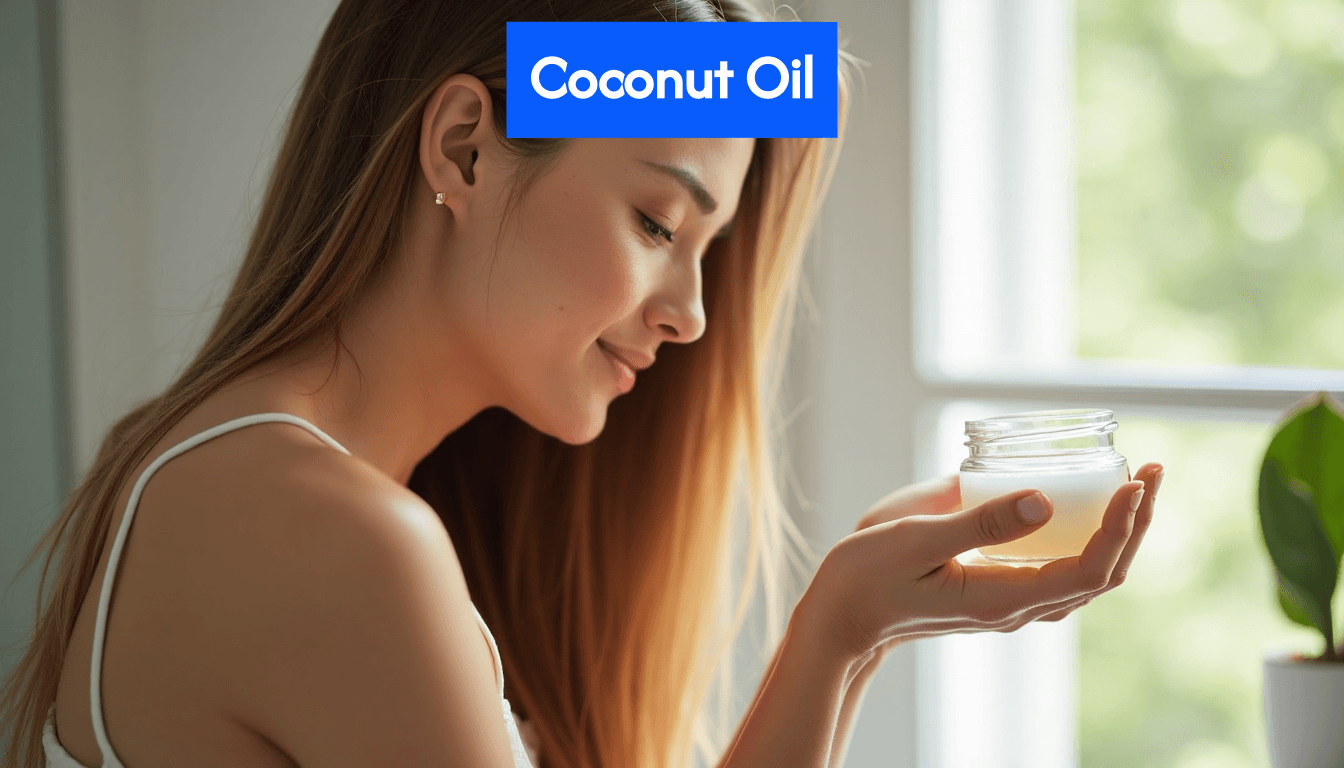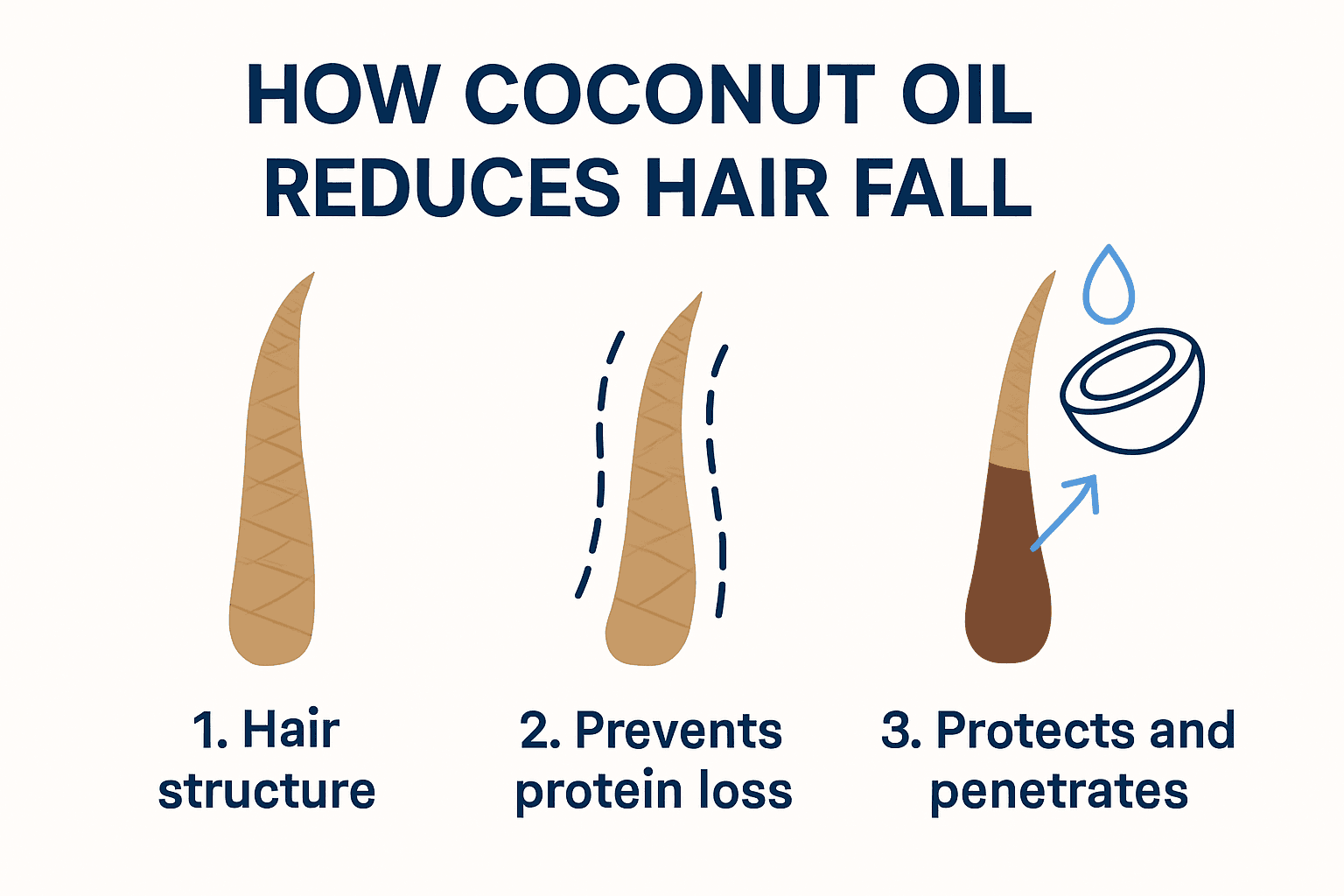Blog
Learning Materials
How to Use Coconut Oil for Hair Fall: Tips & Proven Benefits (2025)
Updated: June 19, 2025

Everyone talks about coconut oil as the ultimate fix for hair fall. Countless social posts praise its magical shine and moisture. Here is the catch. While those benefits matter, the real secret lies much deeper. Scientific reviews from 2024 reveal that coconut oil can actually reduce hair breakage by 41.8 percent—far beyond what most commercial conditioners do. The twist? The way you apply it and track your results changes everything. Prepare to rethink what coconut oil can really do for your hair.
Table of Contents
- Why Coconut Oil Helps With Hair Fall
- Best Ways To Apply Coconut Oil For Hair Loss
- Tracking Hair Growth Progress With Coconut Oil
- Choosing Safe And Effective Coconut Oil Products
Quick Summary
| Takeaway | Explanation |
|---|---|
| Coconut Oil Penetrates Hair | The high lauric acid content in coconut oil allows it to penetrate the hair shaft, creating a protective barrier that reduces protein loss and strengthens hair. |
| Strategic Application is Key | For optimal results, warm the oil and massage it into the scalp, applying it two to three times weekly, with options for pre-wash treatments or overnight masks. |
| Tracking Progress is Essential | Document initial hair and scalp conditions, track changes consistently, and maintain realistic expectations about hair growth outcomes while using coconut oil. |
| Choose Quality Products | Select cold-pressed, unrefined, and virgin coconut oil free from harmful additives, ensuring safety and effectiveness in hair treatments. |
| Combine with Holistic Care | Pair coconut oil use with a balanced diet, proper hydration, and gentle hair handling for maximum benefits in hair health and growth. |
Why Coconut Oil Helps With Hair Fall
Understanding how coconut oil combats hair fall requires a deep dive into its unique molecular structure and powerful hair-strengthening properties. Hair loss is a complex problem that affects millions worldwide, and finding natural solutions has become increasingly important for those seeking effective hair care strategies.
The Science Behind Coconut Oil's Hair Protection Mechanism
Coconut oil stands out among natural hair treatments due to its exceptional ability to penetrate the hair shaft. Research shows that its high lauric acid content allows it to bind with hair proteins, creating a protective barrier that significantly reduces protein loss. This molecular interaction is crucial because protein loss weakens hair strands, making them more prone to breakage and ultimately contributing to hair fall.
The oil's unique composition provides multiple layers of protection. Unlike many synthetic hair treatments, coconut oil can actually penetrate deep into the hair cortex, which means it works from the inside out. This internal strengthening process helps reduce structural damage that leads to hair breakage and loss.

Reducing Hair Fall Through Comprehensive Scalp Care
A 2024 scientific review revealed remarkable statistics about coconut oil's effectiveness. The study found that coconut oil can reduce hair breakage by an impressive 41.8%, while simultaneously improving scalp hydration and minimizing water absorption in hair strands.
The benefits extend beyond simple moisture management. Coconut oil contains antimicrobial properties that help maintain a healthy scalp environment. By reducing fungal and bacterial growth, it creates optimal conditions for hair follicle health. This is critical because scalp infections and inflammation can directly contribute to increased hair fall.
Protein Preservation and Structural Integrity
What sets coconut oil apart from other hair treatments is its ability to preserve hair's structural proteins. When hair loses proteins, it becomes weak, brittle, and more susceptible to breaking. The lauric acid in coconut oil forms a protective coating around hair proteins, essentially creating a shield that prevents unnecessary protein loss during washing, styling, and daily environmental exposure.
This protein preservation mechanism is particularly important for individuals experiencing increased hair fall. By maintaining the hair's internal protein structure, coconut oil helps create more resilient, stronger hair strands that are less likely to break or fall out prematurely.
Applying coconut oil as a regular part of your hair care routine can transform how your hair responds to potential damage. Whether you have naturally thin hair, are experiencing age-related hair thinning, or want to prevent future hair loss, understanding and leveraging coconut oil's scientific properties can be a game-changing approach to hair health.
The evidence is clear: coconut oil is not just another trendy hair care ingredient. It is a scientifically backed solution that offers comprehensive protection against hair fall through its unique molecular interactions and protective properties.
Best Ways to Apply Coconut Oil for Hair Loss
Successful hair loss prevention with coconut oil requires more than simply purchasing the product. Strategic application techniques can maximize its effectiveness and transform your hair care routine. Understanding the correct methods ensures you extract the maximum potential from this natural hair treatment.
Proper Warming and Massage Techniques
Research from health experts recommends a specific approach to applying coconut oil for optimal hair fall reduction. Warm the oil gently to enhance its absorption capabilities. Begin by taking a small amount of coconut oil and heating it to a comfortable temperature—not hot, but warm enough to improve molecular penetration.
Massage the oil into your scalp using circular motions. Focus on areas experiencing significant hair thinning or noticeable hair fall. The massage technique is crucial: use your fingertips to apply gentle pressure, stimulating blood circulation in the scalp. This process should last 5–10 minutes, allowing the oil to penetrate deeply into hair follicles.

Strategic Application Methods
Experts recommend multiple application strategies to maximize coconut oil's benefits. One effective method is the pre-wash treatment: apply the oil 15–20 minutes before shampooing. This technique creates a protective barrier around hair cuticles, reducing damage during washing.
Another powerful approach is the overnight mask. After massaging the oil into your scalp, leave it on for several hours or overnight. Cover your hair with a soft towel or shower cap to prevent oil transfer to your bedding. According to specialized hair care resources, this method allows maximum absorption and provides comprehensive hair and scalp nourishment.
Frequency and Long-Term Application Strategy
Hair care specialists suggest applying coconut oil two to three times weekly for the best results. Consistency is key in addressing hair fall. Each application should last at least 30 minutes, though overnight treatments offer more profound benefits.
Pay special attention to your individual hair type. Fine or thin hair might require less oil, while thick or coarse hair can absorb more. Always start with a small amount and adjust based on your hair's response. For those interested in comprehensive hair growth strategies, check out our guide on advanced hair restoration techniques.
Remember that coconut oil is not a miracle solution but a powerful tool in your hair care arsenal. Combine these application techniques with a balanced diet, proper hydration, and gentle hair handling for the most effective approach to reducing hair fall. Patience and consistent application will yield the most promising results in your journey to healthier, stronger hair.
Tracking Hair Growth Progress With Coconut Oil
Monitoring hair growth when using coconut oil requires a systematic and patient approach. Understanding how to effectively track your progress can help you determine the treatment's effectiveness and make informed decisions about your hair care routine.
Establishing a Baseline and Documentation
Research indicates that while coconut oil offers numerous benefits, scientific evidence for direct hair growth is limited. Therefore, creating a comprehensive tracking method becomes crucial. Start by taking detailed photographs of your scalp and hair from multiple angles under consistent lighting conditions. These initial images will serve as your baseline reference point.
Consider measuring key metrics such as hair density, strand thickness, and overall scalp health. Use a digital caliper or precise measuring tools to track hair strand diameter. Take measurements from multiple sections of your scalp to ensure accuracy. Document these initial measurements in a dedicated journal or digital spreadsheet.
Systematic Observation and Measurement Techniques
Hair care experts recommend tracking progress through multiple parameters. Beyond visual documentation, pay attention to scalp health indicators. Reduced dandruff, decreased scalp irritation, and improved overall scalp condition can signal positive changes.
Establish a consistent measurement schedule. Take progress photos and measurements every 4-6 weeks. This timeframe allows sufficient time for noticeable changes. When documenting, maintain identical conditions: same lighting, camera angle, and hair styling to ensure accurate comparisons. For those seeking comprehensive hair growth strategies, consider supplementing your tracking with additional hair health assessments.
Advanced Tracking and Realistic Expectations
Scientific studies suggest that consistent scalp massage with coconut oil can stimulate blood circulation, potentially supporting hair follicle health. However, it's critical to maintain realistic expectations. Hair growth is influenced by numerous factors including genetics, diet, overall health, and hormonal balance.
Create a comprehensive tracking sheet that includes:
- Weekly application frequency
- Duration of oil application
- Massage techniques used
- Observed changes in hair texture
- Scalp condition notes
- Photographic evidence
Remember that coconut oil is not a miracle solution for hair loss caused by genetic or hormonal factors. While it can improve hair and scalp health, individual results vary significantly. Patience and consistent documentation are key to understanding your personal response to coconut oil treatments.
If after 3-4 months you do not observe meaningful improvements, consult a dermatologist or trichologist. They can provide personalized insights into your specific hair health challenges and recommend targeted interventions beyond topical oil treatments.
Choosing Safe and Effective Coconut Oil Products
Selecting the right coconut oil for hair care involves more than simply grabbing the first product off the shelf. Understanding the nuanced differences between various coconut oil products can significantly impact your hair health and treatment effectiveness.
Quality Indicators and Product Selection Criteria
Experts recommend prioritizing coconut oil products with specific quality markers. Look for labels that explicitly state "cold-pressed," "unrefined," and "virgin" to ensure the oil maintains its natural nutritional profile. These terms indicate minimal processing, which preserves the oil's beneficial fatty acids and essential nutrients crucial for hair health.
Avoid products containing unnecessary additives or chemical preservatives. Pure coconut oil should have a single ingredient: 100% coconut oil. Check the ingredient list carefully to confirm there are no hidden synthetic components that could potentially damage your hair or scalp.
Safety and Purity Considerations
Hair care specialists emphasize the importance of choosing products free from harmful chemicals. Seek out coconut oil that is:
- Paraben-free
- Sulfate-free
- Silicone-free
- Cruelty-free
These criteria ensure you're using a product that is not only safe for your hair but also environmentally conscious. Organic and food-grade coconut oils often meet these standards and provide the highest quality treatment for hair and scalp.
Practical Selection and Application Strategies
Consider your specific hair type when selecting a coconut oil product. Different hair textures may require slightly different approaches. For instance, those with fine hair might prefer a lighter, more easily absorbed oil, while individuals with thick or coarse hair can benefit from more intensive formulations.
For more comprehensive hair care insights, consider consulting professional hair care resources. When purchasing, opt for coconut oils sold in dark glass bottles, which protect the oil from light degradation and maintain its nutritional integrity.
Price should not be the primary deciding factor. While budget-friendly options exist, investing in a high-quality coconut oil can provide more significant long-term benefits for your hair health. Look for reputable brands with transparent sourcing and production methods.
Remember that coconut oil is just one component of a holistic hair care approach. Combine your carefully selected coconut oil with a balanced diet, proper hydration, and gentle hair handling techniques to maximize your hair growth and health potential.
Lastly, always perform a patch test before full application, especially if you have sensitive skin or are prone to allergic reactions. Start with a small amount and observe how your scalp and hair respond to the new treatment.
Frequently Asked Questions
How does coconut oil help with hair fall?
Coconut oil helps reduce hair fall by penetrating the hair shaft, binding with hair proteins, and creating a protective barrier that reduces protein loss. Its antimicrobial properties also improve scalp health, reducing inflammation and conditions that contribute to hair fall.
What is the best way to apply coconut oil for hair loss?
For optimal results, warm the coconut oil and massage it into your scalp using circular motions. Apply it two to three times weekly, either as a pre-wash treatment for 15–20 minutes before shampooing or as an overnight mask for maximum absorption.
How can I track my hair growth progress with coconut oil?
Establish a baseline by taking detailed photographs of your scalp and hair, and measuring key metrics like hair density and strand thickness. Track changes every 4-6 weeks, documenting your observations in a dedicated journal or spreadsheet.
What should I look for when choosing coconut oil for hair care?
Select cold-pressed, unrefined, and virgin coconut oil to ensure the highest quality. Avoid products with additives and chemicals, and choose those labeled as paraben-free, sulfate-free, and cruelty-free for safe applications.
Take the Guesswork Out of Coconut Oil Hair Care
Struggling with ongoing hair fall, protein loss, and uncertainty about what actually works for your scalp? If you are tired of trying home remedies like coconut oil without knowing whether you are really making progress, there is a smarter approach. Experience the confidence that comes from tracking actual hair improvements, not just hoping you are on the right path.

See your unique scalp condition up close with MyHair.ai. Our platform gives you AI-powered hair health analysis and personalized growth projections, so you never have to wonder if your coconut oil routine is making a difference. Upload your hair scan, watch your results evolve over time, and get tailored product recommendations designed for your exact hair goals. Stop guessing and start growing—get your custom analysis on MyHair.ai now.